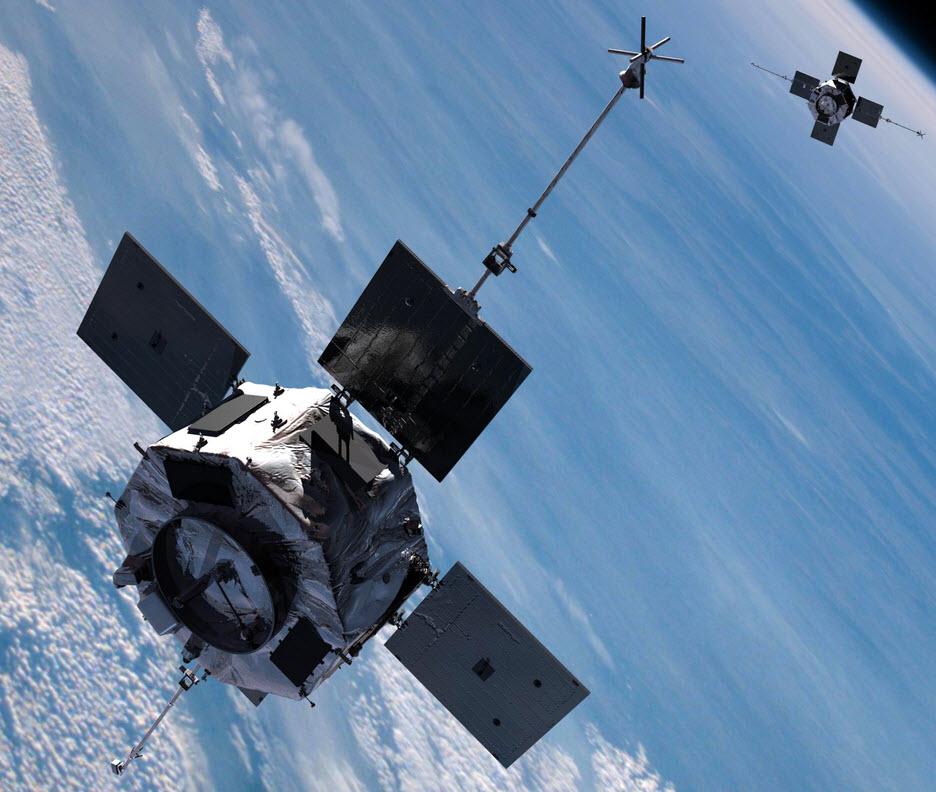Star Trek-like invisible shield discovered 7200 miles above Earth that blocks ‘killer electrons’
December 1, 2014

Scientists have discovered an invisible shield about 7,200 miles above Earth (credit: Andy Kale/University of Alberta)
A team led by the University of Colorado Boulder has discovered an invisible shield some 7,200 miles above Earth that blocks “killer electrons,” which whip around the planet at near-light speed and have been known to threaten astronauts, fry satellites, and degrade space systems during intense solar storms.
The barrier to the particle motion was discovered in the Van Allen radiation belts, two doughnut-shaped rings above Earth — an inner and outer belt extending up to 25,000 miles above Earth’s surface — that are filled with high-energy electrons and protons, said Distinguished Professor Daniel Baker, director of CU-Boulder’s Laboratory for Atmospheric and Space Physics (LASP). Held in place by Earth’s magnetic field, the Van Allen radiation belts periodically swell and shrink in response to incoming energy disturbances from the sun.
In 2013, Baker — who received his doctorate under Van Allen — led a team that used the twin Van Allen probes launched by NASA in 2012 to discover a third, transient “storage ring” between the inner and outer Van Allen radiation belts that seems to come and go with the intensity of space weather.
Shields up
The latest mystery revolves around an “extremely sharp” boundary at the inner edge of the outer belt at roughly 7,200 miles in altitude that appears to block the ultrafast 7.2 MeV electrons from breaching the shield and moving deeper towards Earth’s atmosphere.
“It’s almost like these electrons are running into a glass wall in space,” said Baker, the study’s lead author. “Somewhat like the shields created by force fields on Star Trek that were used to repel alien weapons, we are seeing an invisible shield blocking these electrons. It’s an extremely puzzling phenomenon.”

The identical Van Allen Probes travel through both the inner and outer radiation belts, part of NASA’s Living With a Star Geospace program to explore fundamental processes that operate throughout the solar system, in particular those that generate hazardous space weather effects near the Earth and phenomena that could affect solar system exploration (credit: JHU/APL)
“I think the key here is to keep observing the region in exquisite detail, which we can do because of the powerful instruments on the Van Allen Probes. If the sun really blasts the Earth’s magnetosphere with a coronal mass ejection (CME), I suspect it will breach the shield for a period of time,” said Baker, also a faculty member in the astrophysical and planetary sciences department.
A paper on the subject was published in the Nov. 27 issue of Nature. Other co-authors were from UCLA, Aerospace Corp. Space Sciences Lab in Los Angeles, the University of Minnesota, NASA’s Goddard Space Flight Center in Greenbelt, Maryland, the University of Iowa, and the New Jersey Institute of Technology.
Abstract of An impenetrable barrier to ultrarelativistic electrons in the Van Allen radiation belts
Early observations1, 2 indicated that the Earth’s Van Allen radiation belts could be separated into an inner zone dominated by high-energy protons and an outer zone dominated by high-energy electrons. Subsequent studies3, 4 showed that electrons of moderate energy (less than about one megaelectronvolt) often populate both zones, with a deep ‘slot’ region largely devoid of particles between them. There is a region of dense cold plasma around the Earth known as the plasmasphere, the outer boundary of which is called the plasmapause. The two-belt radiation structure was explained as arising from strong electron interactions with plasmaspheric hiss just inside the plasmapause boundary5, with the inner edge of the outer radiation zone corresponding to the minimum plasmapause location6. Recent observations have revealed unexpected radiation belt morphology7, 8, especially at ultrarelativistic kinetic energies9, 10 (more than five megaelectronvolts). Here we analyse an extended data set that reveals an exceedingly sharp inner boundary for the ultrarelativistic electrons. Additional, concurrently measured data11 reveal that this barrier to inward electron radial transport does not arise because of a physical boundary within the Earth’s intrinsic magnetic field, and that inward radial diffusion is unlikely to be inhibited by scattering by electromagnetic transmitter wave fields. Rather, we suggest that exceptionally slow natural inward radial diffusion combined with weak, but persistent, wave–particle pitch angle scattering deep inside the Earth’s plasmasphere can combine to create an almost impenetrable barrier through which the most energetic Van Allen belt electrons cannot migrate.